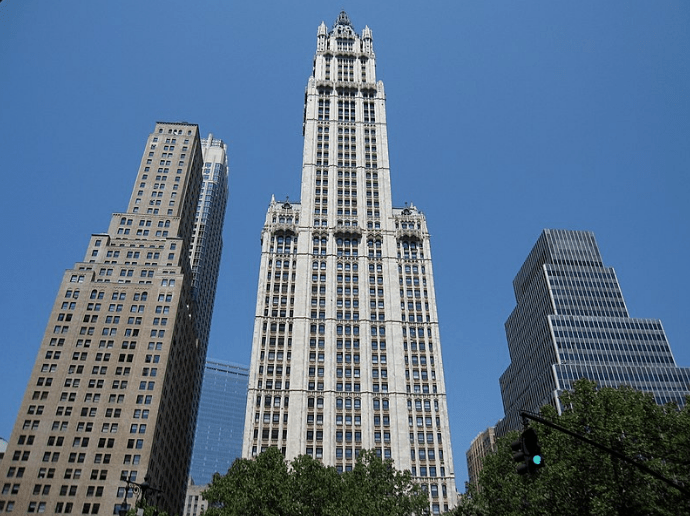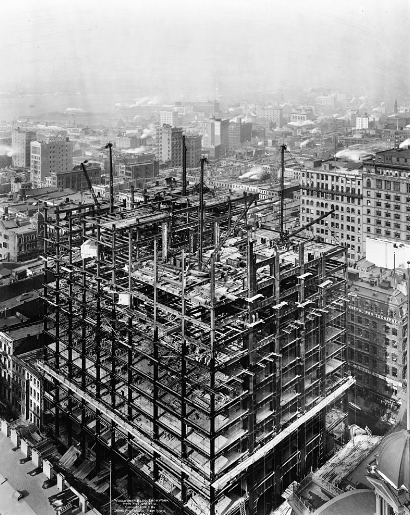The Woolworth building is one of the tallest buildings in New York City, present on 233 Broadway in Manhattan. It is about 792 feet high and was constructed in 1913. It is situated in the Tribeca neighborhood with Broadway and City Hall Park to its east.
The Woolworth building was considered the tallest building in 1913 on its construction. Mr. Frank Winfield Woolworth, a multi-millionaire, was the one who commissioned and financed the construction of this building. This project’s genius architect was Cass Gilbert, a professional who designed and built tall buildings and skyscrapers.
Frank Winfield Woolworth initially owned it but later sold it to the Witkoff Group. The construction began in 1910, and it was completed two years later and was officially opened on April 24, 1913.
History of the Woolworth Building
He constructed the building as a headquarter for his company, all jointly planned with the Irving National Exchange Bank that also agreed to use it as its headquarters. The building was initially designed as a 12 to 16 story commercial building, but several revisions were made during its planning process. Its final height was not decided until January 1911.
The building’s construction began on April 1910 by the demolition of existing buildings around the site, and by August 26, 1911, the building’s foundation was completed. The construction of the skyscraper’s steel frame started on August 15, 1911, and it started rising at the rate of 1.5 stories a week. It was followed closely by the bricklayers attaching terra cotta cladding.
After the completion of the building, Woolworth wanted to buy a share of the skyscraper of Irving National Banks, which reduced the size of the Bank to the size of the tenant. The contract for the Woolworth Building construction was given to the Thompson-Starrett Company, headed by Louis J. Horowitz. The Thompson-Starret Company started operations in 1899 and closed in 1968.
1. The Early Stage of Woolworth Building and Opening
The building was ready to be occupied on May 1, 1913, and Woolworth started advertising the offices for rent starting from $4.00 per square foot. To attract more tenants, he hired an architectural critic known as Montgomery Schuyler to write a 56-page brochure that outlined the building’s features.
He, later on, described the Woolworth building as the “noblest offspring” of buildings constructed with skeletons of steel. By the end of 1914, the building was 70% occupied and generated over $1.3 million a rent every year for F.W. Woolworth Company. By the 1920s, the building had more than a thousand tenants who used suites of one or two rooms.
According to a report, these tenants required over 12,000 people who worked within the building. In 1920 after Woolworth’s death, his heirs took a $3 million mortgage loan on the Woolworth Building from Prudential Life Insurance Company to pay the inheritance tax of $8 million. At this point, the building was worth $10 million, and it grossed $1.5 million per year in rental income.
The corporation sold the building to Woolco Realty Corporation, a subsidiary of the F.W Woolworth Company, in April 1924 for $11 million. The company paid $4 million in cash and got the five-year mortgage of $11 million from the Prudential Life Insurance Company at a 5.5% annual interest rate. The F.W Woolworth Company, later on, sold the building in 1998 to the Witkoff Group.
2. Landmark Status and Restoration
The New York City Landmarks Preservation Commission gave Woolworth building an official status of preservation in 1970. The F.W. Woolworth Company rejected the landmark offer, stating that it will restrict the company from making any modifications to the building’s different aspects. Hence the landmark preservation status was put off.
The F.W Woolworth Company authorized an appraisal, a check of the building’s façade in 1975, and found some severe deterioration of its terracotta. Many blocks of terracotta were loosened or cracked from the continuous thermal expansion caused by New York’s climate. The cracks in the façade were allowing the rain to enter, causing the steel superstructure to rust.
However, in 1977, the F. W. Woolworth Company was finally able to start a five-year renovation of the structure’s earthenware and limestone exterior and substitutions of its windows. Initially, the company had planned to replace the entire terracotta earthenware with concrete to prevent further worsening, but they couldn’t do it due to legal restrictions.
The renovation included the replacement of hardly one-fifth of the building’s terracotta surface and the building’s windows under the care and plan of New York’s architectural firm Ehrenkranz group.
3. Moving Towards Residential
Later on, in 2012, an investment company bought the top 30 floors of the building from the original owners to turn it into luxury apartments and convert the main penthouse into a multi-level space. The project was estimated to cost a lot of money to bring the conversion to fruition. Moreover, it needed approval from the New York attorney general and landmarks preservation commission.
The plan was postponed due to renovations being made, and the added cost of it led to the apartments being even more expensive. In 2014, the building saw a slow start in the sale of condos and apartments, but that also gradually declined.
In 2015, The Blackstone Group provided a 320 million dollar loan to acquire the 30 top building offices, leading to increased sales. The delay in converting the building to residential was expected to be done in 2015, but unfortunately, they weren’t allowed.
The concern was that it would damage the building, and doing anything that would damage it was not allowed due to its history. The owners weren’t given clearance to make changes to major parts that required renovating.
Moreover, the people of the building weren’t even allowed to use the elevators. The plan kept on pushing forward and being delayed due to those reasons. In 2019, it was expected that the conversion would have been completed, but that didn’t happen either. At the same time, the rates of condos and apartments were also made non-negotiable by the owners.
Discover more about the tallest Architectural Wonders of the Big Apple. Visit Sky High – Exploring New York City’s Tallest Architectural Wonders.
Purpose of Construction
F.W. Woolworth had an idea of constructing a skyscraper and mainly wanted to build the tallest office building for his company and his co-sponsors, the Irving National Bank. As the project went on and the building’s construction was completed, it became more advanced over time and became the world’s tallest occupied building.
Previously, the tallest skyscraper in New York was the Singer Sewing Machine Company building, constructed in 1908. Shortly after, the Metropolitan Life Tower took the spot and was then taken by the Woolworth building after it was constructed.
The Architecture of the Building
The Woolworth building’s construction included steel frames, designed by engineer Gunvald Aus with the help of Atlantic Terra Cotta Company. It has carvings and decorations that were inspired by the gothic style of architecture. The building was built with braces to protect against high winds and earthquakes, previously used in constructing bridges.
The building is beautifully decorated with terracotta, but the lower portions are covered with limestone and have thousands of windows. The ornate lobby has several sculptures, mosaics, and architectural touches.
The designer further enhanced the building with beautiful and intriguing amenities and attractions, including the closed observatory on the 57th floor and a private swimming pool in the basement. He designed the building in a U-shape so that every office can get access to the sunlight through one of the windows. Gunvald also designed the building with corridors that run through the middle of each door.
Gilbert further created a grand entrance, three stories high with arched ceilings and mosaic glass windows, walls, and floors made from the marble imported from Greece and Italy. The building has its separate power source, barbershops, restaurants, a doctor’s office, and a swimming pool.
The Woolworth Building – A Historic Landmark of New York
As we can conclude from above, the Woolworth building is a historical piece of art since early 1913. It is a very tall building and offers a very luxurious experience. The Woolworth Building was designed with the state of the art technology and gothic style of architecture, with a unique design, making it one of New York’s most prestigious buildings.


